Newly Renovated Permanent Exhibition Room in April, 2022
Exhibition Room 1: History of Arita Ware
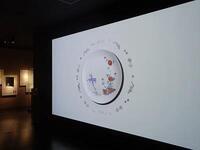 The Kyushu Ceramic Museum has fully renovated its permanent exhibition room under the theme, "The History of Arita Ware". Beginning with Arita ware, the exhibit aims to enhance our ability to convey the charm of ceramics.
The Kyushu Ceramic Museum has fully renovated its permanent exhibition room under the theme, "The History of Arita Ware". Beginning with Arita ware, the exhibit aims to enhance our ability to convey the charm of ceramics.
The exhibit is divided into small rooms and introduces the 400 year history of Arita ware through seven themes. Each room presents the theme in a unique way, allowing visitors to enjoy the history of Arita ware while exploring the rooms.
At the exhibit entrance, exquisitely beautiful images of Arita and Nabeshima ware's designs from the Edo period are projected onto the gigantic dish-shaped screen to welcome visitors.
Room 1: Birth of Japanese Porcelain
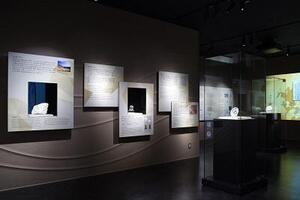 Japanese porcelain was born in and around the Arita area of Hizen during the early Edo period.
Japanese porcelain was born in and around the Arita area of Hizen during the early Edo period.
Initially, objects were produced modelled after Chinese porcelain using technology imported from the Korean peninsula. Later, the area developed into a porcelain-producing region under the protection and management of the Saga domain after high-quality porcelain stone, a raw material from which porcelain is made, was found in Arita.
Room 2: Technical Innovation
About 30 to 40 years after the birth of Japanese porcelain in Arita, porcelain production in the area underwent a dramatic series of technical innovations.
The introduction of technology from China and local improvements combined to create Japan's first porcelain with overglaze polychrome enamelling, while improvements in forming and painting led to the production of products whose high level of quality approached that of Chinese porcelain.
Room 3: Perfection of Japanese Porcelain Kakiemon and Nabeshima
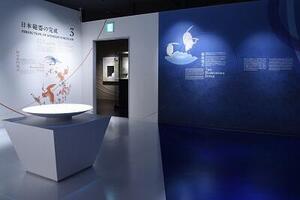 Hizen porcelain underwent further technological development during the second half of the 17th century, leading to the perfection of the Kakiemon style and the Nabeshima style, the two great styles of Japanese porcelain.
Hizen porcelain underwent further technological development during the second half of the 17th century, leading to the perfection of the Kakiemon style and the Nabeshima style, the two great styles of Japanese porcelain.
Kakiemon style porcelain was fired in privately run kilns as premium objects intended for use by European nobility and Japanese lords. By contrast, Nabeshima style porcelain, which boasted refined technique and design, was fired in official kilns operated by the Saga domain for presentation to the family of the shogun.
The two representative masterpieces are on display in this room. They include the Decagonal Dish with Chinese Lion and Peony Design in Overglaze Polychrome Enamels (Kakiemon style), an Important Cultural Property of Saga Prefecture, and the Large Tripod Dish with Heron Design in Underglaze Cobalt Blue (Nabeshima style), a National Important Cultural Property.
(These works may not be on display during exhibition changes)
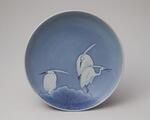
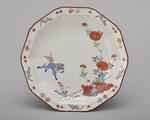 On the dish-shaped screen placed in the middle of the room, beautiful designs of Kakiemon and Nabeshima styles from the Edo period are projected sequentially. The screen shows the entire process, from the painting phase through completion, of each style utilizing animation. Visitors will be able to see such scenes as designs painted in dull colors which turn vivid after the firing process, and more.
On the dish-shaped screen placed in the middle of the room, beautiful designs of Kakiemon and Nabeshima styles from the Edo period are projected sequentially. The screen shows the entire process, from the painting phase through completion, of each style utilizing animation. Visitors will be able to see such scenes as designs painted in dull colors which turn vivid after the firing process, and more.
ROOM 4: Crossing the Ocean
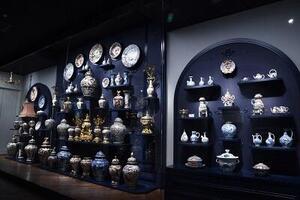 The channels through which Arita ware was sold expanded worldwide as it replaced Chinese porcelain. As a result of disturbances accompanying the transition from the Ming dynasty to the Qing dynasty in China and associated restrictions on trade, the volume of Chinese porcelain exported to other countries declined precipitously around the middle of the 17th century. Dutch merchants for whom Chinese porcelain had been a valuable trade item sought alternatives elsewhere and ultimately chose Arita ware, whose quality at the time was already approaching that of Chinese porcelain.
The channels through which Arita ware was sold expanded worldwide as it replaced Chinese porcelain. As a result of disturbances accompanying the transition from the Ming dynasty to the Qing dynasty in China and associated restrictions on trade, the volume of Chinese porcelain exported to other countries declined precipitously around the middle of the 17th century. Dutch merchants for whom Chinese porcelain had been a valuable trade item sought alternatives elsewhere and ultimately chose Arita ware, whose quality at the time was already approaching that of Chinese porcelain.
This era of Arita ware exports continued for about 100 years, spurring significant growth in Arita's porcelain industry.
ROOM 5: Enrichment of Daily Life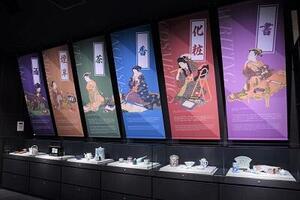 As once-booming overseas exports declined, the porcelain-producing regions of Hizen pivoted to the domestic market, which had been experiencing brisk economic growth.
As once-booming overseas exports declined, the porcelain-producing regions of Hizen pivoted to the domestic market, which had been experiencing brisk economic growth.
As a diverse culture centring on townspeople flourished, various forms of Arita ware designed to meet demand came to enrich daily life in Edo.
ROOM6: Dawn of a New Era
Exports of Arita ware resumed in earnest on the eve of the opening of Japan's ports during the Bakumatsu period. The people responsible for this rejuvenation were two wealthy Arita merchants, Hisatomi Yojibei and Tashiro Monzaemon who inherited the exclusive export right from Hisatomi. Their efforts to develop new types of Arita ware and transform them into recognizable brands by placing their marks front and centre, made a significant contribution to the subsequent development of Arita ware.
ROOM7: Now and in the Future
From the time of its creation down to the present day, Arita ware has transcended the waves of history as it developed over the course of 400 years as a ceramic industry. Ceramics producing artistic porcelain continue to embrace new challenges in an effort to advance their art and rearise even more beautiful creations while building on the traditional wheel and painting techniques developed over generations in Arita. At the same time, manufacturers of everyday tableware and industrial products are realising technological innovation by developing products that meet changing needs as they continue to enrich people's lives.
Arita will presumably continue to evolve as a centre of production of Japanese porcelain, which is widely admired by people both in Japan and overseas, in response to society's needs.
<Themed Exhibitions>
After exploring small gallery rooms arranged in historical order, please enjoy the following four themed exhibitions:
1. How Arita Ware is Made
A process of making overglaze enamel porcelain, which is a traditional method of Arita is explained using actual works.
2. Arita Ware Q&A
Frequently asked questions and terms of Arita ware are explained in this section.
3. Map of Ceramic-Producing Areas in Kyushu
This exhibition provides visitors with information on ceramic-producing regions, including museums and historical sites on the map of Arita, Hizen (Saga and Nagasaki Prefectures), and Kyushu area.
4. Arita Ware Designs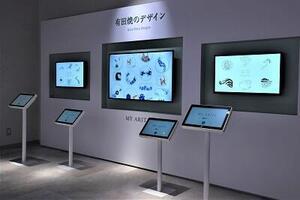 This is an interactive exhibition where you can make an original dish on a monitor by selecting shapes and motifs. You can also take a photo with the dish you created.
This is an interactive exhibition where you can make an original dish on a monitor by selecting shapes and motifs. You can also take a photo with the dish you created.
